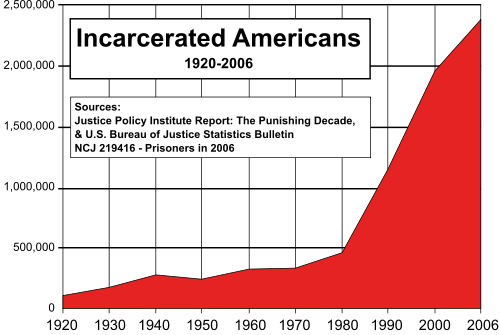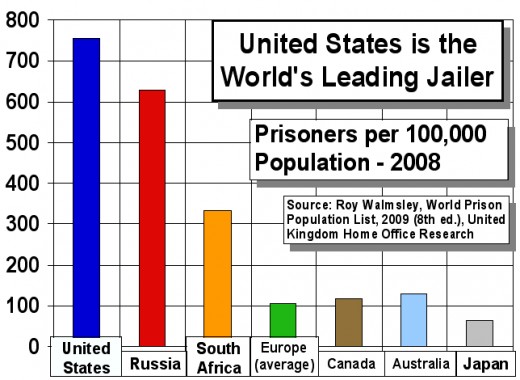America Heading Toward Police State? Over 30% of USA's Younger Population Experiencing Jail or Prison

Is the USA creeping toward becoming a full-fledged police state? Before you dismiss this as a crackpot notion, or shake your head, and say "It can't happen here" ... here's some evidence to consider.
For example, in my article Is Big Brother Watching? You Can Probably Count on It... I have focused on how both government and private entities have revved up efforts to spy on and track the American population — and in a good many cases, public and private authorities are cooperating with one another in this Orwellian crusade.
Now, another indicator has emerged, suggesting just how many young people, one way or another, are ending up in jail or prison. This issue was highlighted several years ago in a New York Times article (19 December 2011) by Erica Goode, who reported that "By age 23, almost a third of Americans have been arrested for a crime ...." This conclusion has been based on a study led by Robert Brame, a professor of Criminal Justice and Criminology at the University of North Carolina in Charlotte, and summarized in a December 2011 article in the journal Pediatrics.
Analyzing the arrest histories of a nationwide sampling of both adolescents and young adults over a range of time, Dr. Brame's investigation found that some 30.2% of 23-year-olds that participated in the study indicated they'd been arrested for an offense other than a minor traffic violation. In the assessment of some researchers, according to the Times article, this high incarceration rate "is a measure of growing exposure to the criminal justice system in everyday life." More alarming, the 30.2% rate is significantly higher than the 22% found in a previous study over a half-century ago, in 1965.
To think that more than one out of five young people has been in jail or prison is fairly staggering ... but to realize that it's now increased to nearly one in three, should cause us all to stop and consider. As discussed below, a complex of factors (including, in many cases, the expansion of both laws and the severity of punishment applying to certain non-violent activities) may be involved in this phenomenon.
These concerns don't mean to imply that a society should not have some way of dealing effectively with sociopaths, whether youths or adults, or anyone that engages in socially destructive behavior. However, as also discussed below, in observing the kind of society that is emerging in the USA, it's worth examining the basic causes for these kinds of problems, and also whether alternative approaches — such as scrutinizing the validity of some repressive measures (like the so-called "War on Drugs"), pursuing effective, bona fide rehabilitation for offenders, and even overhauling society itself — might point to a way to a far better, safer, and more liberated kind of society.

How incarceration "breeds" more criminals
However, over the past several decades, the prevailing trend in criminal "justice" policy has marched in the opposite direction — disparaging rehabilitation, and ratcheting up the harshness of punishment. But is this really smart policy?
Widespread research evidence suggests that, for young people incarcerated for any appreciable time, the prison, jail, or detention center environment (with the opportunity to mix with more hardened criminals) itself tends to inflict harm and serve as a breeding culture or assembly line for schooling young people in criminal methods and lifestyles. In their 2006 book The Dangers of Detention: The Impact of Incarcerating Youth in Detention and Other Secure Facilities Barry Holman and Jason Ziedenberg conclude that juvenile detention facilities frequently are overcrowded and understaffed. They cite as a particularly egregious example a center in Maryland, which managed to crowd 100 young men into cottages officially allowed to have a maximum capacity of only 24 — and with only three to four adults supervising the situation.
According to Mark Soler, in his 2001 book Public Opinion on Youth, Crime and Race: A Guide for Advocates, young people that find themselves in such environments are vulnerable to violent brutality from their peers as well as from staff members, who are themselves described as "often overworked, underpaid and under stress." This violence that incarcerated young people are subject to — ranging from fights and stabbings to rapes — is commonly recognized by criminal justice system employees, as well as critics and opponents of the system. (One could infer from this that such violence may also tend to inculcate and intensify ever more violent behavior, as "violence begets violence".)
And the "breeding culture" effect is also widely documented. For example, in a 1999 study titled “When interventions Harm: Peer groups and Problem Behavior”, published in the journal American Psychologist, T.J., Dishion and his colleagues found that congregating "delinquent youth" has an adverse impact on their behavior — they found "it actually serves to make them more deviant and more of a threat to themselves and others", a process identified by some social scientists as “peer delinquency training”. Young offenders imprisoned in such "congregated" settings have been found to exhibit significantly higher levels of delinquency, difficulties in school, violence, substance abuse, and eventual adjustment difficulties in adulthood, in comparison with youths that were provided treatment in different settings.
Real roots of crime
Undoubtedly, the predominant breeding conditions for crime can be found in America's decaying economic and social fabric — the steady spread of poverty, the loss of job opportunities, the deterioration of much of the public educational system in America's cities, among other factors. In a 2006 statement (posted on the U.S. House of Representatives website) contrasting the declining conditions in the USA with the U.S. government's investment in Iraq, U.S. Representative Charles Rangel of New York City noted that
In major inner cities such as New York unemployment among Black and Hispanic young men is at crisis levels of 50 percent or more. U.S. prisons are filled with our own hopeless and "angry young men" who might never have been locked up if they had been employed, or at least, employable.
Rep. Rangel deplored a federal administration that was "consumed with terrorism and the war in Iraq, while here at home, poverty, unemployment, crime, and the hopelessness that results, are the gravest homegrown threats to our national security." (This very different spin on "national security" is worth noting.)
"In 2006," he pointed out, "one out of three of New York City's children were living in poverty (54 percent for female headed single parent families). With barely 50 percent of the city's Black men holding jobs in 2003, unemployment (and incarceration in many cases) were the main reasons for the father's absence."
Of the 2.2 million Americans locked up in federal, state and local prisons in the U.S. 40 percent are Black. In some large cities such as Baltimore, where the schools are failing and poverty is rampant, more than 50 percent of the young Black men are in prison, on parole or probation. Unlike Iraq, religion is not a cause of their anger. Poverty, ignorance and hopelessness are.
"Lock 'em up" approach making us less safe
As of 2009, the total number of adults in the USA either in jail or prison, or on probation or parole, amounted to more than 7.2 million — 3.1% of America's resident population. According to Human Rights Watch, "the extraordinary rate of incarceration in the United States wreaks havoc on individuals, families and communities, and saps the strength of the nation as a whole." Whose "strength" is being "sapped" in a severely fractious nation, deeply divided by income inequality, is dubious, but this staggering number of people ensnared one way or another in the criminal justice system certainly must be having a deleterious impact on family life as well as the social and economic fabric.
This is particularly troubling when you realize that the USA has "the highest documented incarceration rate in the world", according to Wikipedia — followed by Russia and then Rwanda. Currently the population of inmates incarcerated in U.S. prisons and jails totals about 2.3 million.
One of the major causes of such high incarceration rates is the extraordinary length of prison sentences in the USA, which dispenses far longer sentences than any other country on earth. Thus, says Wikipedia, "Even though other countries have more prisoners annually, the fact that the United States keeps their prisoners longer causes the total rate to become higher."
Many analysts also ascribe these trends to the gradual ratcheting-up of restrictions and laws within the USA — in other words, the more things you make illegal, the wider the net you cast, and the more people you'll find violating the new restrictions. In addition, criminal penalties for some infractions (such as drug-law violations) have been significantly increased over the past several decades. Indeed, reports Wikipedia, "One of the biggest contributors to the United States' spike is the war on drugs."
Further reinforcing this criticism, Wikipedia notes that America incarcerates a large number of non-violent and "victimless" offenders. Approximately 50% of all individuals incarcerated under state jurisdiction are imprisoned for non-violent offenses, and, in state prisons, 20% are incarcerated for drug offenses (in federal institutions, the percentages are even higher).
To be sure, some extremely unsavory, vicious, even bloodthirsty characters are engendered, under the conditions of modern American society, and manage to roam free, preying on an overwhelmingly innocent and well-intentioned population that does its best to abide by the prescribed rules. (Those of us that have been crime victims know this, and, if you haven't been directly impacted, watching just a few of the chilling crime stories featured on network TV news programs like NBC's Dateline and CBS's 48 Hours should provide a sobering reality check.)
Many fairly stern law-and-order enthusiasts might argue that the increased rate of incarceration is a small price to pay for a safer lifestyle. But actually, over the past several decades, America hasn't gotten safer — it's gotten less safe, if you gauge this by the crime rate. The US violent crime rate increased by more than 150% over the 50-year period 1960-2010 (Wikipedia). America's homicide rate remains among the highest in the industrialized world.
Moreover, even if you applaud widening the net of criminal offenses, and the tougher sentencing laws, scooping up ever-larger segments of the population into jail or prison ought to give you at least some pause. Cycling more and more people — especially youths and young adults — through the criminal justice system would not seem to bode well for modern society, no matter who's actually at fault, or what the root cause is.

"Police State Creep"?
So, returning to the initial issue ... does this suggest America is becoming a police state? Certainly, a growing prison population (and even the huge proportion of young people ending up behind prison walls) doesn't itself suddenly define America as a police state. But when you combine that with signs of an increasingly regulated and regimented society — the gradual tightening of restrictions (on public protests, for example) and the imposition of increasingly intrusive laws (like the so-called Patriot Act) — the picture of the society that is emerging tends to give many Americans cause for concern.
Some have started calling it "Police State Creep" — a sinister slipping and sliding into police-state characteristics. In any case ... this confluence of developments tends to suggest that something seems to be going terribly wrong, and perhaps more of us should be taking notice.
■








